Echinodermata - Study guides, Class notes & Summaries
Looking for the best study guides, study notes and summaries about Echinodermata? On this page you'll find 149 study documents about Echinodermata.
Page 3 out of 149 results
Sort by
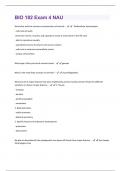
-
BIO 182 Exam 4 NAU Questions And Answers With Verified Solutions
- Exam (elaborations) • 15 pages • 2024
- Available in package deal
-
- $7.99
- + learn more
Be familiar with the common characteristics of animals. - - Multicellular heterotrophs - cells lack cell walls -most have nerves, muscles, and capacity to move at some point in the life cycle - able to reproduce sexually - specialized sensory structures and nervous system - cells exist in extensive extracellular matrix - unique cell junctions What type of life cycle do all animals show? - gametic What is the most likely ancestor of animals? - choanoflagellates What are the 3 major featu...

-
Bio 117 exam 2 quiz with 100% correct solutions
- Exam (elaborations) • 49 pages • 2024
- Available in package deal
-
- $13.49
- + learn more
Bio 117 exam 2 quiz with 100% correct solutions Which of the following is NOT a characteristic of ALL animals? A. Heterotrophic B. Together, they form a monophyletic group. C. Multicellular organisms D. Cells lacking cell walls. E. All animals have true tissues and organs. - Correct Answer ️️ -All animals have true tissues and organs. Which of the following are characteristics of Phylum Cnidaria? (Select All that Apply) A. Specialized stinging cells B. True Tissues C. Comp...

-
ASVAB General Science, asvab, asvab general science Test 2024
- Exam (elaborations) • 47 pages • 2024
-
- $15.49
- + learn more
ASVAB General Science, asvab, asvab general science Test 2024 Mnemonic for classification - ANSWER King Philip Came Over From Germany Soaked 3 unicellular kingdoms - ANSWER archaebacteria, eubacteria, Protista 3 multicellular kingdoms - ANSWER fungi, plantae, animalia Unicellular kingdom that has nucleus and organelles - ANSWER Protista 10 animal phyla - ANSWER porifera, cnidaria, platyhelminthes, nematoda, rotifera, annelida, mollusca, arthropoda, echinodermata, chordate 3 muscle types...
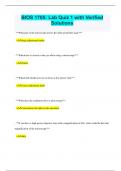
-
BIOS 1705: Lab Quiz 1 with Verified Solutions
- Exam (elaborations) • 5 pages • 2024
-
- $9.99
- + learn more
BIOS 1705: Lab Quiz 1 with Verified Solutions - **What part of the microscope moves the slide around the stage?** - Stage adjustment knobs - **Which lens is closest to the eye when using a microscope?** - Ocular - **What knob should you use to focus at low power only?** - Coarse adjustment knob - **What does the condenser do in a microscope?** - Concentrates the light on the specimen - **If you have a high power objective lens with a magnification of 40x, what would be the ...
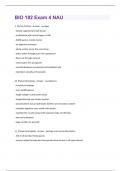
-
BIO 182 Exam 4 NAU QUESTIONS & ANSWERS RATED 100% CORRECT!!
- Exam (elaborations) • 15 pages • 2024
- Available in package deal
-
- $7.99
- + learn more
1. Phylum Porifera - Answer-- sponges - loosely organized and lack tissues - multicellular with several types of cells - 8,000 species, mostly marine - no apparent symmetry - adults sessile, larvae free-swimming - water drawn through pores into spongocoel - flows out through osculum - choanocytes line spongocoel - mesohyl between choanocytes and epithelial cells - reproduce sexually and asexually 10. Phylum Nematoda - Answer-- roundwomrs - in nearly all habitats - over 20,000 specie...
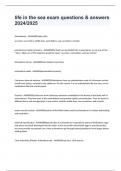
-
life in the sea exam questions & answers 2024/2025
- Exam (elaborations) • 11 pages • 2024
-
Available in package deal
-
- $8.99
- + learn more
life in the sea exam questions & answers 2024/2025 Echinoderms - ANSWERS(Spiny skin) sea stars, sea urchins, brittle stars, sand dollars, sea cucumbers, crinoids pentamerous radial symmetry - ANSWERSthe body can be divided into 5 equal parts, so any one of five "slices" taken out of the organism would be equal. "sea stars, sand dollars, and sea urchins" Echinoderm larvae - ANSWERShave bilateral symmetry echinoderm adult - ANSWERSpentaradial symmetry Calcareous internal skel...
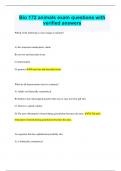
-
Bio 172 animals exam questions with verified answers
- Exam (elaborations) • 19 pages • 2024
- Available in package deal
-
- $9.99
- + learn more
Bio 172 animals exam questions with verified answers Which of the following is (are) unique to animals? A) the structural carbohydrate, chitin B) nervous and muscular tissue C) heterotrophy D) gametes B) nervous and muscular tissue What do all deuterostomes have in common? A) Adults are bilaterally symmetrical. B) Embryos have pharyngeal pouches that may or may not form gill slits. C) All have a spinal column. D) The pore (blastopore) formed during gastrulation becomes the anu...
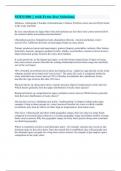
-
SOES1006 || with Error-free Solutions.
- Exam (elaborations) • 11 pages • 2024
-
- $10.49
- + learn more
Mollusca, Arthropoda, Chordata, Echinodermata, Cnidaria, Porifera correct answers Phyla found in the rocky intertidal By size: macrofauna are larger than 1mm and meifauna are less than 1mm correct answers How do scientists define macrofauna and meiofauna? Chlorophyta (green), rhodophyta (reds), phaeophyta (browns - fucoids and kelps) correct answers The 3 different divisions of macroalgae found on rocky shores Primary producers (micro and macroalgae), grazers (limpets, periwinkles, urch...
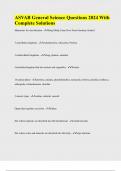
-
ASVAB General Science Questions 2024 With Complete Solutions
- Exam (elaborations) • 50 pages • 2024
- Available in package deal
-
- $12.44
- + learn more
Mnemonic for classification - King Philip Came Over From Germany Soaked 3 unicellular kingdoms - archaebacteria, eubacteria, Protista 3 multicellular kingdoms - fungi, plantae, animalia Unicellular kingdom that has nucleus and organelles - Protista 10 animal phyla - porifera, cnidaria, platyhelminthes, nematoda, rotifera, annelida, mollusca, arthropoda, echinodermata, chordate
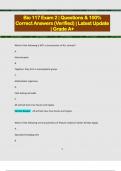
-
Bio 117 Exam 2 | Questions & 100% Correct Answers (Verified) | Latest Update | Grade A+
- Exam (elaborations) • 59 pages • 2024
-
- $14.09
- + learn more
Which of the following is NOT a characteristic of ALL animals? A. Heterotrophic B. Together, they form a monophyletic group. C. Multicellular organisms D. Cells lacking cell walls. E. All animals have true tissues and organs. Correct Answer: All animals have true tissues and organs. Which of the following are characteristics of Phylum Cnidaria? (Select All that Apply) A. Specialized stinging cells B. 2 True Tissues C. Complete digestive system D. Nerve Net Correct ...

$6.50 for your textbook summary multiplied by 100 fellow students... Do the math: that's a lot of money! Don't be a thief of your own wallet and start uploading yours now. Discover all about earning on Stuvia


